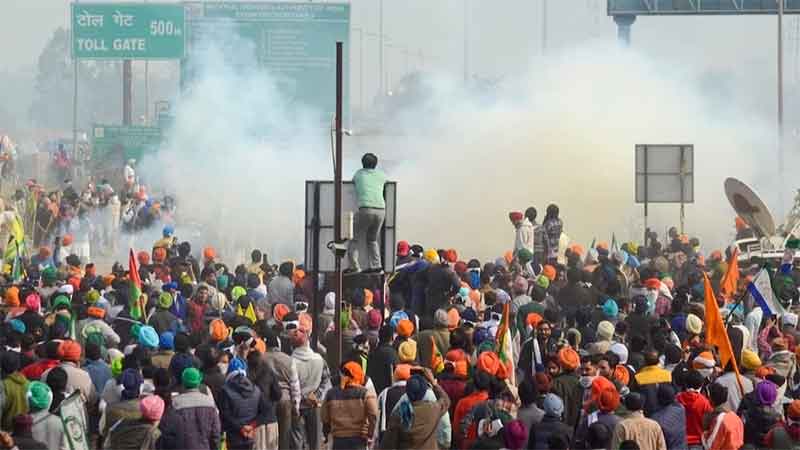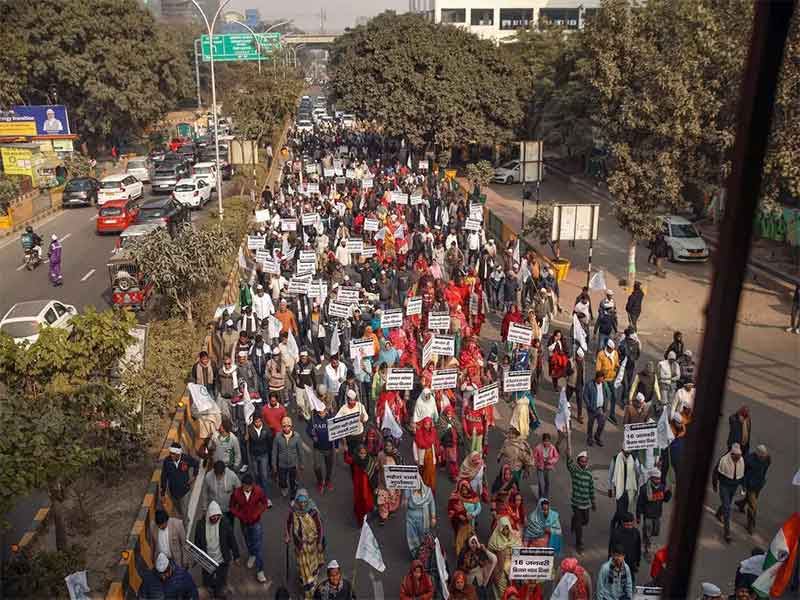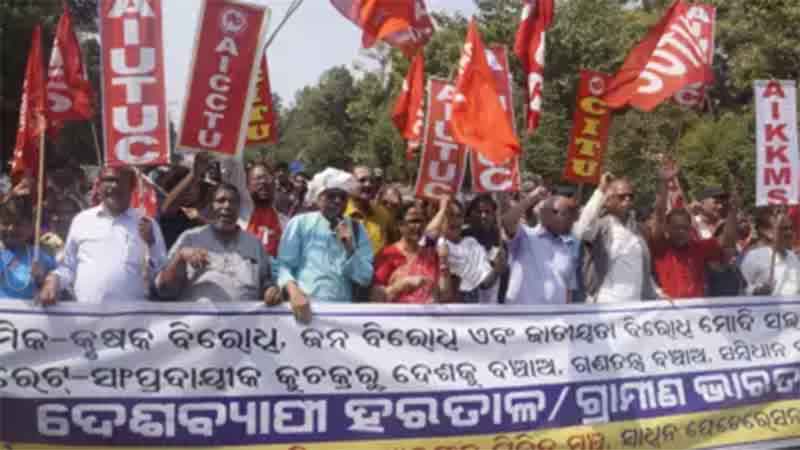Thousands of farmers, most of them from Punjab, are seeking to enter the capital Delhi. Feb 16 all India shut down or Bharat Bandh, including this time a ‘Grameen Bharat Bandh, begins. A Group of Ministers of the Union Govt held the third round of discussions on Feb 15, and the Fourth Round is slated for Feb 18 Sunday. It is further reported that the police placed an order for an additional 30,000 rounds of tear-gas shells; they were already used to prevent the onward march of the farmers. The Samyukta Kisan Morcha (SKM)- Non-political, on Feb 13, had written to PM Modi seeking his intervention to initiate discussions on a 21-point charter of demands, shown below.

21 point charter of demands. Chart courtesy: Times of India, Feb 14, 2024. See demands of farm workers, shown separately : There is no mention at all of the land question, discussed by the Swaminathan Commission.
Times of india reported: “Apart from legal guarantee for procurement of all crops at MSP using C2+50% formula, in line with Swaminathan Commission recommendations, other key demands include farm loan waiver, no increase in power tariff (which is free in several states), free electricity up to 300 units, no smart meters (a provision of the Electricity Act), comprehensive crop insurance, punishment to guilty of Lakhimpur Kheri violence of 2021, and pensions for farmers and farm labourers.”
Ashok Gulati , renowned economist, now Infosys Chair Professor for Agriculture, summed up and wrote:
“There are many voices and demands. It’s useful to break it down to core issues…
● Minimum support prices (MSPs) of 23 crops should receive a statutory legal backing.
● MSP to be fixed at 50% above the comprehensive cost of production. This includes actual cost incurred to grow crops and assumed values for other items such as family labour.
● Loan waivers and pensions.
● The grab bag of demands also spans trade policy, such as pulling out of WTO. (Times of India, Feb 14.)
The issues involved and demands raised by farmers are old. We are presently not going into them. The key basis has been the Swaminathan Commission, tasked with finding solutions to problems faced by farmers, which significantly discussed the land question, but which is missing in most of the analyses and reports.
MS Swaminathan (1925 Aug-2023 Sep), father of India’s green revolution, was in the news recently for the posthumous Bharat Ratna, the highest award conferred by the Govt of India. But they are not ready to go into the land question he had raised.
The awards were admittedly timed with the General Elections scheduled for this summer. So is timed the farmers’ agitation that commenced.
More than 50 years after green revolution that basically addressed the staple foodgrain self-sufficiency, farmers still complain of systemic neglect by the various governments at the Centre and in states.
The Modi-led govt, mouthing Swaminathan, blames the Opposition and foreign forces for backing the farmers’ agitation. But the Commission after all was linked with CMP of the then UPA, a previous edition of the present Opposition INDIA alliance.
PRS Legislative Research, a leading research group “ with the mission to strengthen India’s democracy by helping Parliament and state assemblies be more effective,” had stated:
“The National Commission on Farmers (NCF) was constituted on November 18, 2004 under the chairmanship of Professor M.S. Swaminathan. The Terms of Reference reflected the priorities listed in the Common Minimum Programme (CMP). The NCF submitted four reports in December 2004, August 2005, December 2005 and April 2006 respectively. The fifth and final report was submitted on October 4.”
The Commission, over the years, has been reduced to MSP etc, a distortion of a larger perspective: It had said farmers needed assured access and control over resources such as land and water. The reports contain suggestions to achieve the goal of “faster and more inclusive growth” as envisaged in the Approach to 11th Five Year Plan. There can be no inclusive growth without addressing the farm labor and the land question. Sab ka saath sab ka vikas is meaningless if it ignores them.
However, the focus is mostly on MSP, stressed by the agitators, mouthed by all political parties and highlighted by the media.
indiatoday.in, Jun 1, 2018 , had summed up the Commission report as follows:
“ The Swaminathan Commission identified certain causes for farm distress. These are:
- Unfinished agenda in land reform
- Quantity and quality of water
- Technology fatigue
- Access, adequacy and timeliness of institutional credit
- Opportunities for assured and remunerative marketing
- Adverse meteorological factors aggravate these problems
The commission concluded that farmers needed to have assured access and control over basic resources including land, water, bio-resources, credit and insurance, technology and knowledge management, and markets.”
Evidently, key issues listed above are not in focus the way they should have been.”Unfinished agenda in land reform, quantity and quality of water,” particularly of interest to the rural poor including the landless peasants, i.e., the farm labor and tenants, are almost forgotten – by one and all.
Income and wealth inequality in India is often mentioned, citing Oxfam International. But the same is ignored, if not forgotten, while discussing the rural scene. It is so even by the Left parties and democratic forces, not to speak of ruling classes and their media.
Swaminathan Commission Suggestions, reported by indiatoday.in, were as follows:
- To distribute ceiling-surplus and waste land among farmers: The share of the bottom half of the rural households in the total land ownership was only 3 per cent and the top 10 per cent was as high as 54 per cent. One of the demands of the agitating farmers today is that they should be made the owner of the land they have been tilling for years.
- To prevent diversion of prime agricultural land and forest to corporate sector for non-agricultural purposes.
- To ensure grazing rights and seasonal access to forests to tribals and pastoralists, and access to common property resources.
- To establish a National Land Use Advisory Service: This would have the capacity to link land use decisions with ecological meteorological and marketing factors on a location and season-specific basis.
- To set up a mechanism to regulate the sale of agricultural land, based on quantum of land, nature of proposed use and category of buyer.
(indiatoday.in, Jun 1, 2018.)
Except for a few, the farmers’ organizations as well as political forces including those of the Left underplayed, nay almost forgot the land question, which was acknowledged, not long ago, even by the ruling classes.
MSP has been the sole focus currently, and that mostly pertains to the surplus farmers, in particular the landlords and the rich farmers. These classes have genuine issues and demands, no doubt. But forgetting the rural poor and their land question can not be condoned.
As long as the land question and the demands of the rural poor, who constitute the largest proportion among the rural population, are left out, the unity remains limited and so will be the impact of the agitation.
The very Terms of Reference for the commission included ‘’special programmes for dryland farming for farmers in the arid and semi-arid regions, as well as for farmers in hilly and coastal areas.” It is the rural poor, including the adivasis, who are concerned about these issues. And they are forgotten. Most of the resources are spent on huge irrigation projects, involving massive costs and scams, benefiting basically the landed rich, leaving the rural poor high and dry.
Key Findings and Recommendations by the Commission included:
Agrarian distress has led farmers to commit suicide in recent years. The major causes of the agrarian crisis are: unfinished agenda in land reform, quantity and quality of water, technology fatigue, access, adequacy and timeliness of institutional credit, and opportunities for assured and remunerative marketing. But the focus has been on MSP, and the exclusion of demands of the rural poor is glaring.
The terms included “policy reforms to substantially increase flow of rural credit to all farmers” but institutional credit to the middle and poor farmers have been limited, and they are at the mercy of private moneylenders who are often linked with markets of farm inputs as well as outputs, and thus robbed. Suicides of poor farmers and tenants have been linked to indebtedness, institutional credit being denied to the rural poor.
The Commission, based on land holdings data given below, stressed: Land reforms are necessary to address the basic issue of access to land for both crops and livestock. Land holdings inequality is reflected in land ownership.
In 1991-92, the share of the bottom half (see first two rows) of the rural households in the total land ownership was only 3.8 % and the top 10% was as high as 54%.
Distribution of Land
| Land Holding | % of House holds | % of Land hold |
| Land less | 11.24 | |
| Sub-margin holdings (0.01 – 0.99 acres) | 40.11 | 3.80 |
| Marginal holdings (1.00 – 2.49 acres) | 20.52 | 13.13 |
| Small holdings (2.50 – 4.99 acres) | 13.42 | 18.59 |
| Medium holdings (5 – 14.99 acres) | 12.09 | 37.81 |
| Large holdings (15 acres + above) | 2.62 | 26.67 |
| 100.0 | 100.0 |
Source: Table 1 of the Fifth NCF Report based on Some Aspects of Household Ownership Landholdings-1991-92. NSS Report-399.
Out of the (then) gross sown area of 192 million ha, rainfed agriculture contributes to 60 per cent of the gross cropped area and 45 per cent of the total agricultural output. It is mostly the rural poor who depend more on rain-fed agriculture, and contribute.
Some of the main recommendations of the Commission, based on above data, include:
- Distribute ceiling-surplus and waste lands;
- Ensure grazing rights and seasonal access to forests to tribals and pastoralists, and access to common property resources. (again, it is part of the land question.)
- Prevent diversion of prime agricultural land and forest to corporate sector for non-agricultural purposes.
- Establish a National Land Use Advisory Service, which would have the capacity to link land use decisions with ecological meteorological and marketing factors on a location and season specific basis.
Set up a mechanism to regulate the sale of agricultural land, based on quantum of land, nature of proposed use and category of buyer.
Land question obviously is a crucial part of the recommendations.
The report also recommended:
- A comprehensive set of reforms to enable farmers to have sustained and equitable access to water.
- Increase water supply through rainwater harvesting and recharge of the aquifer should become mandatory.
- Substantial increase in investment in irrigation sector under the 11th Five Year Plan apportioned between large surface water systems; minor irrigation and new schemes for groundwater recharge.
In practice, heavy investments and scams are found in large irrigation schemes that benefit the landed rich in the main. These classes grab all water resources – both surface and underground. Land has borders and fences, but the waters have none. The waters under the land held by the rural poor are also sucked away by powerful pumps, subsidized the by the pro-landlord state. There are no statistics on waters robbed.
The politicians and bureaucrats who have a large share in the cake also hail from the same exploiting classes, and so they are not bothered about rural poor.
The land concentration, notwithstanding all the claims of land reforms, remains high to this day. Data from the Agricultural Census 2010-11, the latest available, show that the top 15% of “operational holdings” (OH)operate about 55 percent of the total farmland. Conversely, 85 % holdings operate 45% land. The OH data, it should be noted, conceals the land concentration because one landlord controls not one OH, but many, more than one for sure.
Agriculture still provides the bulk of employment in the rural areas, the Commission noted, and recommended measures.
“ The overall employment strategy in India must seek to achieve two things. First, create productive employment opportunities and second to improve the ‘quality’ of employment in several sectors such that real wages rise through improved productivity. The measures to do so include:
- Emphasizing on relatively more labour intensive sectors and inducing a faster growth of these sectors; and
- Improving the functioning of the labour markets through such modification as may be necessary without eroding the core labour standards.
Bio-resources:
Rural people in India depend on a wide range of bio-resources for their nutrition and livelihood security. The report recommends:
- Preserving traditional rights of access to bio-diversity, which include access to non-timber forest products including medicinal plants, gums and resins, oil yielding plants and beneficial micro-organisms;
- Conserving, enhancing and improving crops and farm animals as well as fish stocks through breeding;
- Encouraging community-based breed conservation (i.e. conservation through use);
- Allowing export of indigenous breeds and import of suitable breeds to increase productivity of nondescript animals.
The above aspects concerning rural poor, including in particular the adivasis (STs) and farm labor, are mostly forgotten by the government as well as all parties involved. When the rural poor, including adivasis, insist and fight for their rights, they are suppressed with an iron hand.
(For a summary of the Commission recommendations, cited above, visit,
https://prsindia.org/policy/report-summaries/swaminathan-report-national-commission-farmers.)
*** ***
Why the land question is ignored by major sections of the farmers’ movements? ‘Farmers’, as different from ‘peasants’, is a loose word that includes landlords – land owners – who are not merely big land owners, but those who never tilled or tended their land, and are at the centre of landlord system, old or new, semi-feudal or capitalist. ‘Rich peasants’ are also land-rich, but they attended to farm work. ‘Peasants’ include the middle, poor and landless peasants. It is these classes who are interested in agrarian revolution. DV Rao had explained the class differentiation in India, including in rural India.
Agrarian revolution, with abolition of landlordism and land to the tiller as its central slogan, is essential for India’s development. That has been the stand of DV Rao (1917-1984), veteran communist revolutionary, hailed as the father of the theory and practice of Agrarian Revolution In India. Countercurrents.org published a series of articles on the subject.
See Comrade DV Rao: Unique Role In Indian Communist Movement
https://countercurrents.org/2020/07/comrade-dv-rao-unique-role-in-indian-communist-movement/
see article by Anand Teltumbde: “DV Rao, The Father Of The Theory And Practice Of Agrarian Revolution In India” : Countercurrents, 2020.
Questions have been raised that it is “no more relevant in capitalist India.” It was explained to be a wrong formulation. The situation did not change with 1947, or even later, explained an article in CC. A comprehensive development of India- Modi’s sab ka sath sab ka vikas – is impossible without an agrarian revolution. See for example..
See Indian State post-1947 Served Imperialists and Strengthened Landlord Base (13/08/2019.)
Even in Punjab, among the most capitalistically developed agrarian regions of India, a significant viewpoint acknowledges the centrality of the land question and agrarian revolution. See this report:
“ Today the B.K.U.(Ekta-Ugrahan) is the strongest peasant organization In Punjab which normally constitutes about 75% of the participants in the major revolutionary force’s gatherings or rallies” …it is of the “ firm view that semi-feudalism persists in Punjab and capitalist relations have not been fully developed. It launches most of its struggles challenging dictates of MNC’s or Corporates but mantains that the base of oppression is feudalism.” .. .They stressed the need for the landed peasants to wage a protracted struggle against usury, cancellation of debts, opposing corporate seizure of lands etc.They also stressed the need on uniting with the landless peasants… BKU(Ugrahan) is igniting the spark of resistance confronting economic neo-fascism which is literally strangulating the peasantry and oppressed classes..”
See…Crystallization of Mass Revolutionary Movement in Punjab in the last 25 years –Tribute to the mass line of T.Nagi Reddy, 18/10/2020
Even capitalist countries needed agrarian revolution for their transformation. India can be no exception.
Agrarian revolution, with abolition of landlordism and land to the tiller as its central slogan, is the basic pre-requisite to development, not only of the landless poor but of the entire country, and to the socio-economic transformation including the abolition of caste oppression and discrimination.
*** ***
(The author is a political analyst who regularly contributed to the countercurrents.org.)













































